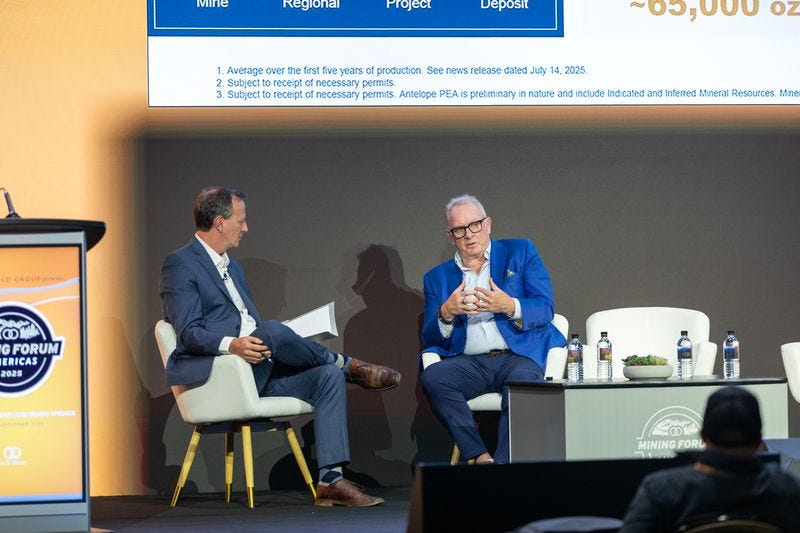West Africa Gold Miners: Adding Ounces, Navigating Headwinds
Speed, Discipline, Optionality: The West African Gold Thesis in 2025
From the Mining Forum Americas 2025 (MFA25) stages in Colorado Springs, the message was clear: West Africa remains one of the world’s most productive and dynamic gold regions.
The MFA25 presenters with West African exposure—from focused operators like West African Resources [WAF:AU, $2.02, $2.31B] and Allied Gold [AAUC:CN, $15.09, $1.74B], to diversified majors like AngloGold Ashanti [AU:US, $64.52, $32.57B], Barrick [B:US, $29.48, $50.29B], B2Gold [BTO:CN, $4.34, $5.74B], Kinross Gold [K:CN, $22.46, $28.35B], Gold Fields [GFI:SJ, $38.35, $34.33B], and Endeavour Mining [EDV:LN, $38.18, $9.19B], plus developers and royalty financiers—collectively outlined a story of growth tempered by above-ground challenges.
Shared Themes Across the Belt
1. Speed to build and ramp.
Projects in Côte d’Ivoire, Burkina Faso, Mali, and Ghana still move from permit to production faster than in the Americas. Recent examples include Kiaka (West African Resources) and the Seguela expansion (Fortuna [FVI:CN, $7.90, $2.42B]).
2. Fiscal and political drift.
Mali’s 2023 mining code and Burkina Faso’s royalty/ownership demands dominated discussions. Resolute Mining [RSG:AU, $0.56, $1.19B] called Syama a “world-class asset in the wrong jurisdiction today”, while B2Gold admitted the “penalty box” effect of Mali’s shifting terms.
U.S. Ambassador to Mali, Rachna Korhonen, attended MFA25 and was hosted at a breakfast organized by Allied Gold and B2Gold. She pleaded with investors to return to Mali, but will return to the State Department with a clear message that the instability in the country is causing concern. Two years ago, U.S. NGOs linked to Western intelligence and military interests distributed pamphlets at the Mining Forum, which were critical of companies operating in Mali.
3. Power and logistics.
Côte d’Ivoire’s grid and hydrology cycles were cited as real constraints. West African Resources flagged the importance of Kiaka’s grid connection, and Resolute noted explosives import delays in Mali.
4. Local content as an advantage.
Workforces are >90% national: Orezone Gold [ORE:CN, $0.91, $542.5M] (97% Burkinabè), Resolute (93% Malian), West African Resources (93–95% Burkinabè). Several highlighted community funds and local partnerships as strategic moats.
5. Balance sheet discipline.
Fortuna and Perseus Mining [PRU:AU, $2.79, $3.78B] stressed “fortress” positioning: expanding margins not just from price, but by controlling costs and funding growth internally.
Company Highlights
West African Resources [WAF:AU, $2.02, $2.31B] — Kiaka commissioned ahead of schedule; Sanbrado steady at 200 koz+. Targeting 500 koz/year by 2029 while managing Burkina’s equity demands.
Allied Gold [AAUC:CN, $15.09, $1.74B] — Production set to double on Sadiola (Mali) + Côte d’Ivoire complex expansions.
Montage Gold [MAU:CN, $4.45, $1.61B] — Koné project (~300 koz/year) nearing production; oxide startup could accelerate first gold. Backed by Wheaton Precious Metals and Triple Flag streams.
Fortuna [FVI:CN, $7.90, $2.42B] — Seguela expansion (Côte d’Ivoire) and Diamba Sud growth (Senegal) support 500 koz/year target; fortress balance sheet intact.
Orezone Gold [ORE:CN, $0.91, $542.5M] — Oxide mine built during COVID; Stage 1 hard-rock expansion finishing; Stage 2 to push >220-250 koz/year, funded largely from cash flow.
Resolute Mining [RSG:AU, $0.56, $1.19B] — Mako (Senegal) cash cow; Syama (Mali) steady but constrained; Doropo (Côte d’Ivoire) on track for 2028.
Perseus Mining [PRU:AU, $2.79, $3.78B] — Yaouré (Côte d’Ivoire) transitioning to underground; Nanzaga (Tanzania) adds growth.
Endeavour Mining [EDV:LN, $38.18, $9.19B] — Guiding 1.11–1.26 Moz in 2025 from five West African mines at low AISCs.
Robex Gold [RBX:CN, $2.69, $586.1M] — Kiniero (Guinea) first gold imminent; targeting 150 koz/year.
Galiano Gold [GAU:CN, $2.40, $621.1M] — Asanko (Ghana) growth + 82% production increase from 2024 levels.
B2Gold [BTO:CN, $4.34, $5.74B] — Fekola (Mali) expansion to add ~180 koz/year; company reframing Mali exposure.
IAMGOLD [IMG:CN, $11.03, $6.34B] — Essakane (Burkina Faso) remains large, but company de-risking the balance sheet by reducing reliance by mid-2026.
Kinross Gold [K:CN, $22.46, $28.35B] — Tasiast (Mauritania) >500 koz/year, “firing on all cylinders.”
Gold Fields [GFI:SJ, $38.35, $34.33B] — Tarkwa (Ghana) with strong life-extension potential.
AngloGold Ashanti [AU:US, $64.52, $32.57B] — Obuasi (Ghana) on track to guidance.
Barrick [B:US, $29.48, $50.29B] — Loulo-Gounkoto (Mali) remains one of the world’s largest complexes.
Conclusion
West Africa’s gold belt continues to out-execute many jurisdictions: faster permitting, quicker ramps, and ample brownfield runway. What stood out at MFA25 was not hype but discipline—operators leaning on local workforces, grid tie-ins, and stage-gated capex to convert geology into durable margins. The region’s “tax of uncertainty” (Mali’s code shifts, Burkina Faso equity/royalty pressure, and power/logistics friction) is real, but leading teams are managing it with balance-sheet strength and optionality rather than single-bet megaprojects.
If that discipline holds, 2026–2029 should be a self-funded growth window: Kiaka’s contribution layered onto Sanbrado, Séguéla’s expansion and Senegal pipeline work, Yaouré’s underground, Fekola’s regional ounces, and new entrants like Kiniero and—on a longer fuse—Koné. The majors provide scale and diversification; the mid-tiers offer torque; royalties/streams add lower-beta exposure to the same cash-flow inflection.
What to watch next (near-term catalysts):
Fiscal clarity: tangible movement on Mali/Burkina frameworks (permits, equity asks, stability terms).
Power reliability: grid connections/hydrology through the dry season, especially in Côte d’Ivoire.
Ramp quality: Kiaka optimization, Séguéla throughput and underground studies, Fekola regional permitting.
First gold milestones: Kiniero; construction/financing lock-ins and updated timelines for Koné.
Capital allocation: buybacks/dividends vs. incremental growth, signaling confidence in cash durability.
Bottom line: MFA25 confirmed that West Africa can still compound ounces and cash—so long as operators keep doing the unglamorous things well: localize, de-risk the power/logistics, and spend only when the rulebook is clear. That playbook turns an address under the spotlight into a potentially durable franchise.



